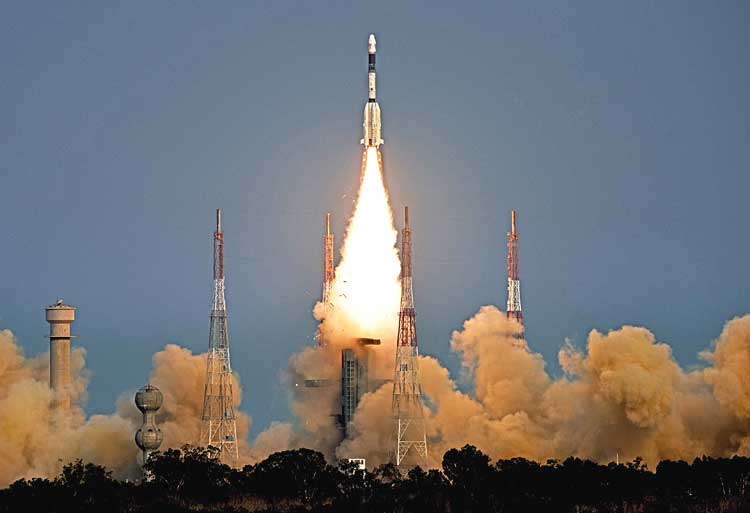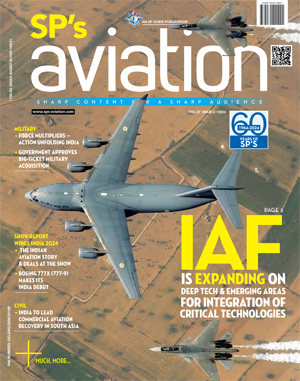INDIAN ARMED FORCES CHIEFS ON
OUR RELENTLESS AND FOCUSED PUBLISHING EFFORTS

SP Guide Publications puts forth a well compiled articulation of issues, pursuits and accomplishments of the Indian Army, over the years

I am confident that SP Guide Publications would continue to inform, inspire and influence.

My compliments to SP Guide Publications for informative and credible reportage on contemporary aerospace issues over the past six decades.
The fiasco of GSAT-6A
 |
By Lt. General P.C. Katoch (Retd) Former Director General of Information Systems, Indian Army |

On March 29, 2018, ISRO launched the communication satellite GSLV Mk-II (GSLV-F08); carrying the 2,140kg GSAT-6A, it took off from Sriharikota and some 17 minutes later the three-stage rocket injected the satellite into a geosynchronous transfer orbit. This was the Geosynchronous Satellite Launch Vehicle's 12th flight and sixth with indigenous cryogenic upper stage. In coming days, ISRO scientists were to fire the onboard thrusters to manoeuvre it to a geostationary orbit at an altitude of 36,000km from earth. In this launch, ISRO used the high thrust indigenous cryogenic 'Vikas' engine that has increased thrust by 6 per cent, consequently enhancing the payload capacity by 50 per cent - 2.5 tons in this case.
The second stage planned also had electromechanical actuation system replacing electro-hydraulic actuation to enhance reliability of the rocket. These improvements and more are to be incorporated into GSLV's future missions, including Chandrayaan-2 planned for October 2018. However, after the successful long duration firings, when the satellite was on course to normal operating configuration for the third and the final firing, scheduled for April 1, 2018, communication from the satellite was lost at 9.30 AM on March 31. This is definitely a major setback but ISRO is making efforts to re-establish the communication link. Only after the communication link is re-established with the satellite can it be placed in its intended orbit. This may be a difficult proposition even if it is a case of mechanical / technical failure. On the other hand, if it has been caused by sabotage, then the satellite may be considered lost. The fact is that the space is fast becoming an ambiguous battleground. China's space lab may be out of control and hurtling towards earth, but not only has it lived its life, its point of impact on earth may be fixed by China, though proclaimed out of control. China would already have considerable space capabilities and R&D in space would have been accelerated after Tianjin Port was stuck by a space weapon in August 2015. With China fixated with limiting India's strategic space and curbing our economy, wouldn't she love to sabotage ISRO's satellite that would boost mobile communications in India, including of Indian Armed Forces? The underlying fact is that such possibility cannot be discounted. Cause for the downing of an IAF Sukhoi close to the LAC in May 2017 was suspected by foreign analysts as a cyber-attack by China. Possibly same was the reason for downing of a UAV during the Doklam standoff, so why not a satellite? GSAT-6A, similar to its predecessor GSAT-6, is a high power S-band communication satellite with a mission life of some 10 years. It has a has a six-metre wide antenna that is meant for S-band communication; three times broader than those generally in ISRO satellites, which will enable the satellite to provide mobile communication for the country through handheld ground terminals, whereas, smaller antenna in other communication satellites require larger ground stations. This will also benefit Armed Forces in use of hand-held mobile terminals. GSAT-6A will complement GSAT-6, which has been providing satellite communication services since its launch on August 27, 2015. ISRO is preparing for three launch campaigns including PSLV-C41 carrying IRNSS-1I, to be launched shortly followed by GSLV Mk-III.
India has plenty catching up to do in terms of mobile internet speed and broadband speed around the world. India was ranked 109 out of 122 in the Speedtest Global Index in November 2017, as also 76 rank out of 133 countries in broadband speed. For this, ISRO is planning to launch heavy-duty communication satellites. GSAT-11 is planned to be launched in April-May this year, with the 5,725-kg satellite carrying 40 transponders in the Ku-band and Ka-band frequencies aimed at providing high bandwidth connectivity with up to 14 gigabit per second (Gbps) data transfer speed. Om June 5, 2017, ISRO had launched GSAT-19, which too carried Ka/Ku-band high throughput communication transponders. Simultaneous to GSAT-11 planned to be launched from the European spaceport in April-May, ISRO will launch GSAT-29 through GSLV Mk III rocket from Sriharikota. Thereafter, GSAT-20 is planned to be launched in 2019. All these satellites together will provide high bandwidth connectivity of up to 100 gigabit per second; provide high-speed internet connectivity in rural areas as well and help bridge the digital divide. These satellites use multiple spot beams through a special transponder operating on high frequency, which increases internet speed and connectivity; spot beam being a satellite signal specially concentrated in power to cover limited geographical area on the earth. The narrower the beam more is the power. Moreover, these satellites will reuse the beams several times in order to cover entire India.
GSAT-19 uses 16 beams and is able to transfer data at the rate of 13 Gbps. GSAT-20 will use 40 beams. Each beam will have two polarisations, which will effectively make them 80 beams. This satellite will have data transfer rate of 60-70 Gbps. Interestingly, American Elon Musk, owning Space X is also building the largest satellite-based internet network in the world to bring low-cost high-speed internet to billions of people. Space X has already launched two experimental internet-based satellites; Microsat-2a and Microsat-2b. Space X plans to launch a constellation of 800-1,200 small satellites of 4,425 Ka/Ku band into the low-earth orbit, aimed at enabling Space X establish global internet services by 2020, though it may not cover the whole world. Many may not know that ISRO is helping 125 government projects work effectively and efficiently by optimizing space technology, mainly for social-welfare and development projects including MGNREGA, navigation system and land demarcation plans. ISRO has repeatedly proved to be one of the most efficient and dedicated organization in the country with recurring achievements that have made India proud. If it has set its sight on making mobile internet speed and broadband speed in India world class, there is no reason it will not achieve it. This year is also launch of Chandrayaan-2 mission. In case GSAT-6A is required to be re-launched, Chandrayan-2 may be delayed. But Indians will be looking forward to future ISRO missions.





